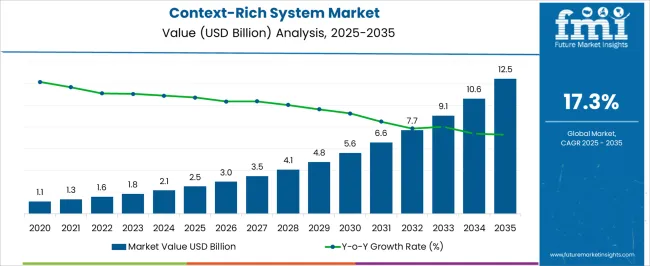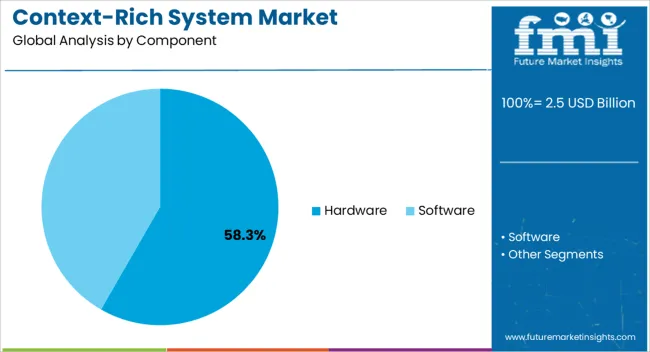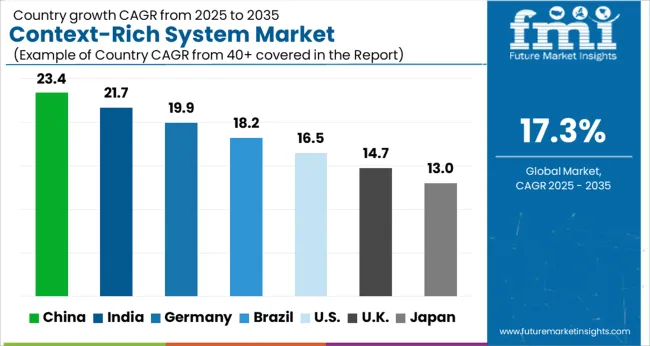The Context-Rich System Market is estimated to be valued at USD 2.5 billion in 2025 and is projected to reach USD 12.5 billion by 2035, registering a compound annual growth rate (CAGR) of 17.3% over the forecast period.

| Metric | Value |
|---|---|
| Context-Rich System Market Estimated Value in (2025 E) | USD 2.5 billion |
| Context-Rich System Market Forecast Value in (2035 F) | USD 12.5 billion |
| Forecast CAGR (2025 to 2035) | 17.3% |
The context rich system market is witnessing robust momentum as industries increasingly leverage contextual data for real time decision making, personalization, and enhanced user experiences. The integration of advanced sensors, AI algorithms, and data analytics is enabling systems to capture, interpret, and act on situational information with greater accuracy.
Rising adoption of connected devices, expansion of IoT ecosystems, and demand for predictive intelligence in both consumer and enterprise applications are key contributors to market expansion. Regulatory emphasis on secure data usage and the growing role of digital transformation initiatives across financial services, healthcare, and retail are reinforcing adoption trends.
With continuous advancements in edge computing, 5G networks, and cloud platforms, the market outlook remains highly positive as enterprises focus on deploying scalable and intelligent context aware solutions to optimize efficiency and enhance customer engagement.

The hardware segment is projected to account for 58.30% of total revenue by 2025 within the component category, making it the dominant segment. This leadership is attributed to the rising integration of sensors, processors, and embedded systems that enable context aware functionalities in multiple devices.
Hardware innovations have facilitated improved data collection, enhanced computational efficiency, and seamless connectivity, which are essential for delivering real time contextual insights. Investments in miniaturization and energy efficient chipsets are further boosting hardware adoption across mobile and wearable devices.
As enterprises and consumers increasingly demand smarter and more interactive solutions, the hardware segment continues to establish itself as the foundational driver of growth in the context rich system market.

The smartphones segment is expected to hold 65.20% of market revenue by 2025, positioning it as the leading device category. The widespread use of smartphones as primary digital interaction tools, combined with their advanced capabilities in sensing, data processing, and connectivity, has made them central to context rich applications.
Features such as geolocation, biometric authentication, and AI based assistants are enhancing the role of smartphones in delivering real time personalized services. Their integration into mobile banking, health monitoring, and retail personalization is further accelerating demand.
Continuous advancements in device performance and global 5G expansion are ensuring that smartphones remain the most prominent platform for deploying context rich system functionalities.

The BFSI vertical is projected to contribute 24.60% of overall market revenue by 2025, marking it as the dominant industry application. Growth in this segment is being driven by the need for advanced fraud detection, personalized customer engagement, and regulatory compliance through real time data interpretation.
Financial institutions are adopting context aware systems to enhance transaction security, streamline digital onboarding, and improve customer service through predictive insights. The rising emphasis on mobile banking and digital wallets has further strengthened reliance on context aware technologies.
By leveraging behavioral and situational data, BFSI organizations are able to reduce risks, enhance trust, and deliver tailored financial services. This consistent integration of context rich systems within core operations has established BFSI as the leading vertical in driving market adoption.
By integrating signals related to location and activities, context-rich systems pull out data such as the mode of transportation being used by a persona and the weather in their city. With the help of using this information, these systems provide users with an exceedingly personalized experience.
The market growth of context-rich systems is driven by factors such as increasing penetration of mobiles and connected devices and the development of networking services and software technologies. Additionally, the growth of the context-rich systems market is propelled by the trend toward contextually relevant data sharing, demand for context-aware security, and ubiquitously embedded intelligence.
Presently, several enterprises are utilizing context-rich systems to provide personalized advertisements to their users. Context-rich systems are expected to play a vital role in the development and implementation of content marketing activities. These enterprises focus on enhancing their brand presence.
In line with this goal, key decision enterprises are allocating a significant share of their marketing budgets to content marketing and an appreciable portion of these investments are expected to flow into the context-rich systems market.
Artificial Intelligence (AI) and Machine Learning (ML) Integration: These technologies enable systems to analyze and understand vast amounts of contextual data. Leading to more accurate and personalized user experiences.
Internet of Things (IoT) Connectivity: Context-rich systems are leveraging IoT connectivity to gather data from various sensors and devices, enabling a deeper understanding of user context.
Natural Language Processing (NLP) and Conversational Interfaces: Voice assistants, chatbots, and natural language understanding capabilities are becoming more sophisticated. Allowing users to communicate with systems more conversationally and intuitively.
Contextual Advertising and Marketing: By analyzing user context, including location, preferences, behavior, and demographics, these systems can deliver highly relevant and timely advertisements to users.
Augmented Reality (AR) and Virtual Reality (VR) Integration: These technologies enable the overlay of digital information onto the physical world, enhancing contextual understanding and providing users with a richer and more engaging experience.
Enhanced Security and Privacy Measures: Emerging trends focus on robust data protection mechanisms, encryption, user consent management, and compliance with data privacy regulations.
Cross-industry Applications: The versatility and adaptability of context-rich systems make them valuable across diverse sectors, driving their adoption and market growth.
As context-rich systems rely heavily on advanced algorithms, data processing, and intelligent decision-making, software plays a crucial role in enabling the functionality and capabilities of these systems. Software components in context-rich systems encompass a wide range of technologies, including artificial intelligence (AI), machine learning (ML), natural language processing (NLP), data analytics, and contextual reasoning. These components work together to collect, analyze, and interpret contextual data, enabling systems to understand user behavior, preferences, and environmental factors.
While software components enable the intelligence and functionality of these systems, hardware components provide the physical infrastructure and resources necessary for their operation. Hardware components in context-rich systems encompass a wide range of devices and equipment. Including sensors, cameras, microphones, processors, memory modules, storage devices, displays, and networking infrastructure. These components work together to collect, process, and transmit data, enabling the system to understand and respond to its surrounding context.
Smartphone devices are recording a progressive growth trajectory of 16.0% during the analysis period. They incorporate a range of hardware components such as sensors, cameras, microphones, processors, and displays, which enable the capture and processing of contextual data. Additionally, smartphones are equipped with various connectivity options like Wi-Fi, cellular networks, and Bluetooth. Allowing seamless communication and integration with other devices and systems. They act as personal assistants, enabling users to access location-based services and receive personalized recommendations. Moreover, interact with augmented reality applications, and perform various context-aware tasks.

The market is likely to capture a 23.5% CAGR during the forecast period. India, with its large population and expanding digital infrastructure, presents a significant opportunity for the adoption of context-rich systems.
The increasing availability of smartphones, affordable internet access, and advancements in technology have fueled the demand for context-rich applications and services among Indian consumers. Furthermore, the availability of affordable smartphones and data plans has made context-rich systems more accessible to a larger segment of the population. This affordability factor has played a crucial role in driving the adoption of context-rich systems across different socio-economic segments in India.
Brazil, as one of the emerging economies in Latin America, presents a promising market for context-rich systems. The increasing digitalization, widespread smartphone usage, and advancements in technology have contributed to the growth of the market in the country. This indicates a significant growth trend in the adoption and implementation of context-rich systems in the country.
Brazilian consumers are increasingly seeking personalized experiences and convenience in their interactions with digital platforms and services. Context-rich systems, with their ability to provide tailored and relevant content, meet these evolving consumer expectations.
Japan is projected to achieve a compound annual growth rate (CAGR) of 15.9% in the context-rich systems market during the forecast period from 2025 to 2035. The increasing integration of context-rich technologies in various sectors such as healthcare, retail, transportation, and entertainment is driving market expansion. These sectors are recognizing the value of context-rich systems in delivering personalized and tailored experiences to their customers, resulting in improved efficiency and customer satisfaction. Furthermore, the changing consumer expectations and preferences for personalized experiences are driving the demand for context-rich systems in Japan.
These companies are actively involved in research and development activities, strategic partnerships, and product innovations to gain a competitive edge. Here are some prominent players in the context-rich systems market:
Recent Development
| Attribute | Details |
|---|---|
| Growth Rate | CAGR of 17.34% from 2025 to 2035 |
| Base Year of Estimation | 2025 |
| Historical Data | 2020 to 2025 |
| Forecast Period | 2025 to 2035 |
| Quantitative Units | Revenue in USD billion and Volume in Units and F-CAGR from 2025 to 2035 |
| Report Coverage | Revenue Forecast, Volume Forecast, Company Ranking, Competitive Landscape, growth factors, Trends, and Pricing Analysis |
| Key Segments Covered | Component, Devices, Vertical, Region |
| Regions Covered | North America; Latin America; Europe; East Asia; South Asia; The Middle East & Africa; Oceania |
| Key Countries Profiled | The United States, Canada, Brazil, Mexico, Germany, Italy, France, The United Kingdom, Spain, Russia, China, Japan, India, GCC Countries, Australia |
| Key Companies Profiled | Microsoft; IBM; Oracle; Broadcom; Salesforce; Ping; Identity; Okta; HID; Global; ForgeRock; CyberArk |
| Customization & Pricing | Available upon Request |
The global context-rich system market is estimated to be valued at USD 2.5 billion in 2025.
The market size for the context-rich system market is projected to reach USD 12.5 billion by 2035.
The context-rich system market is expected to grow at a 17.3% CAGR between 2025 and 2035.
The key product types in context-rich system market are hardware and software.
In terms of devices, smartphones segment to command 65.2% share in the context-rich system market in 2025.






Our Research Products

The "Full Research Suite" delivers actionable market intel, deep dives on markets or technologies, so clients act faster, cut risk, and unlock growth.

The Leaderboard benchmarks and ranks top vendors, classifying them as Established Leaders, Leading Challengers, or Disruptors & Challengers.

Locates where complements amplify value and substitutes erode it, forecasting net impact by horizon

We deliver granular, decision-grade intel: market sizing, 5-year forecasts, pricing, adoption, usage, revenue, and operational KPIs—plus competitor tracking, regulation, and value chains—across 60 countries broadly.

Spot the shifts before they hit your P&L. We track inflection points, adoption curves, pricing moves, and ecosystem plays to show where demand is heading, why it is changing, and what to do next across high-growth markets and disruptive tech

Real-time reads of user behavior. We track shifting priorities, perceptions of today’s and next-gen services, and provider experience, then pace how fast tech moves from trial to adoption, blending buyer, consumer, and channel inputs with social signals (#WhySwitch, #UX).

Partner with our analyst team to build a custom report designed around your business priorities. From analysing market trends to assessing competitors or crafting bespoke datasets, we tailor insights to your needs.
Supplier Intelligence
Discovery & Profiling
Capacity & Footprint
Performance & Risk
Compliance & Governance
Commercial Readiness
Who Supplies Whom
Scorecards & Shortlists
Playbooks & Docs
Category Intelligence
Definition & Scope
Demand & Use Cases
Cost Drivers
Market Structure
Supply Chain Map
Trade & Policy
Operating Norms
Deliverables
Buyer Intelligence
Account Basics
Spend & Scope
Procurement Model
Vendor Requirements
Terms & Policies
Entry Strategy
Pain Points & Triggers
Outputs
Pricing Analysis
Benchmarks
Trends
Should-Cost
Indexation
Landed Cost
Commercial Terms
Deliverables
Brand Analysis
Positioning & Value Prop
Share & Presence
Customer Evidence
Go-to-Market
Digital & Reputation
Compliance & Trust
KPIs & Gaps
Outputs
Full Research Suite comprises of:
Market outlook & trends analysis
Interviews & case studies
Strategic recommendations
Vendor profiles & capabilities analysis
5-year forecasts
8 regions and 60+ country-level data splits
Market segment data splits
12 months of continuous data updates
DELIVERED AS:
PDF EXCEL ONLINE
System-On-Package Market Size and Share Forecast Outlook 2025 to 2035
Systems Administration Management Tools Market Size and Share Forecast Outlook 2025 to 2035
Systemic Sclerosis Treatment Market - Trends & Forecast 2025 to 2035
System on Module Market Growth – Trends & Forecast 2025 to 2035
SLE Drugs Market Insights - Growth & Forecast 2025 to 2035
Systemic Mastocytosis Treatment Market
Systemic Infection Treatment Market
5G System Integration Market Insights - Demand & Growth Forecast 2025 to 2035
VRF Systems Market Growth - Trends & Forecast 2025 to 2035
Rail System Dryer Market Size and Share Forecast Outlook 2025 to 2035
HVAC System Analyzer Market Size and Share Forecast Outlook 2025 to 2035
DWDM System Market Analysis by Services, Product, Vertical, and Region – Growth, Trends, and Forecast from 2025 to 2035
Brake System Market Size and Share Forecast Outlook 2025 to 2035
Cloud Systems Management Software Market Size and Share Forecast Outlook 2025 to 2035
Hi-Fi Systems Market Size and Share Forecast Outlook 2025 to 2035
X-ray System Market Analysis - Size, Share, and Forecast 2025 to 2035
Power System Simulator Market Growth - Trends & Forecast 2025 to 2035
Cough systems Market
Atomic System Clocks Market Forecast and Outlook 2025 to 2035
Closed System Transfer Devices Market Insights – Industry Trends & Forecast 2024-2034

Thank you!
You will receive an email from our Business Development Manager. Please be sure to check your SPAM/JUNK folder too.
Chat With
MaRIA